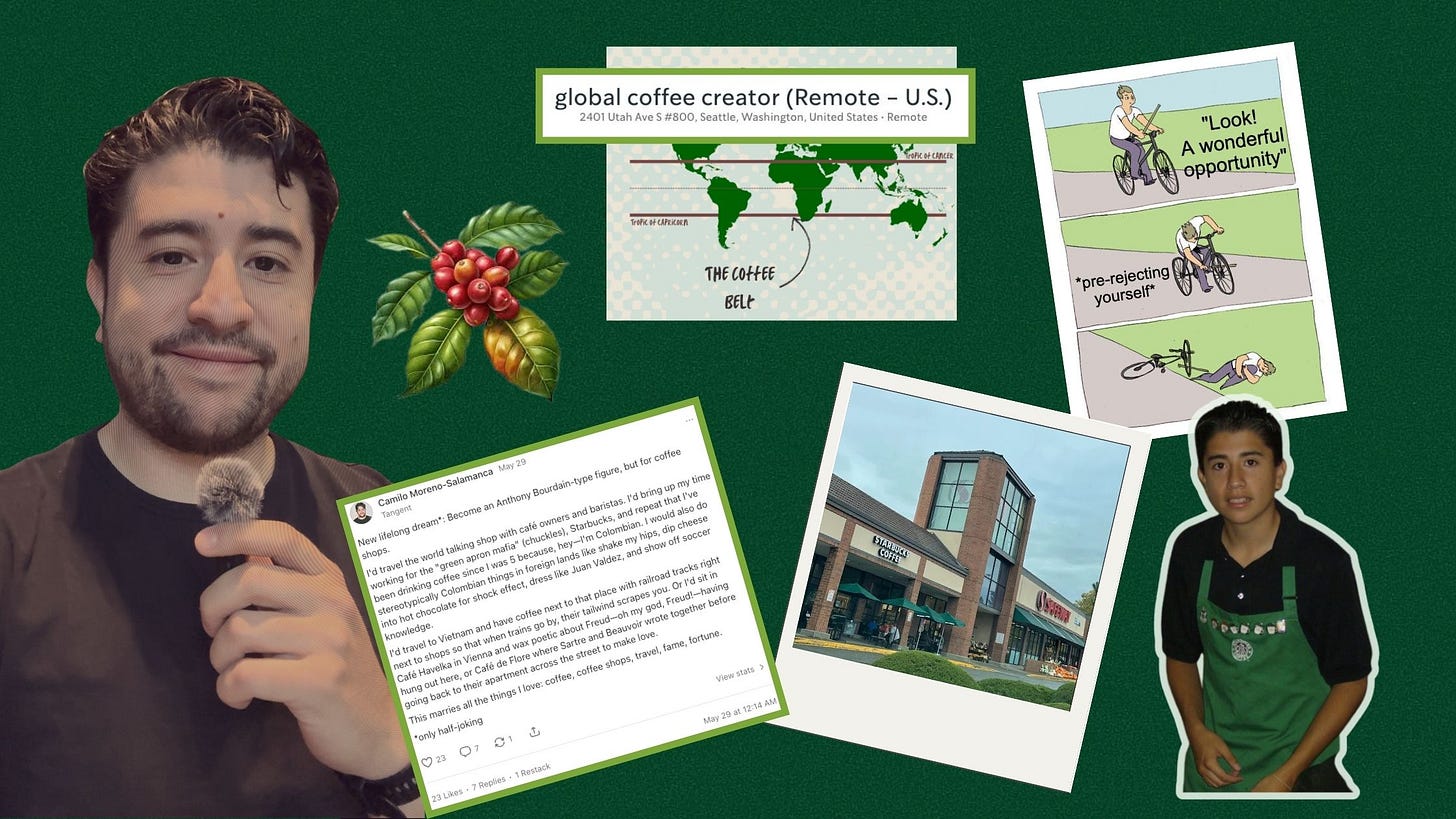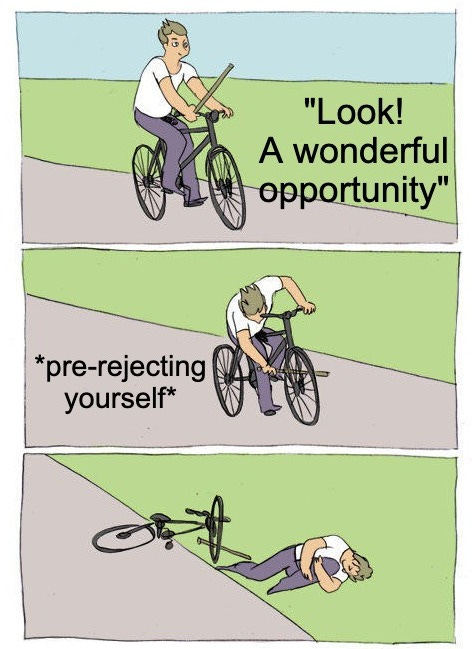Becoming Intrepid
Overcoming self-rejection
On a sleepless night a few weeks ago, I posted the following note on Substack:
This wasn’t a life-long dream that was revealed in the stillness of night. It was a spontaneous thought that escaped the confines of my inner monologue.
The next day, I saw this:
Traveling the world around different Starbucks, telling stories about coffee and getting paid to do it? It was a sweet coincidence.
I reviewed the application process. It seemed reasonable except for one small thing: I had to submit a TikTok video making the case as to why Starbucks should hire me to be a “global coffee creator.”
This was going to be a problem.
To start, I’ve avoided using TikTok.1 I also have a strong aversion to recording myself; I dread seeing how the right corner of my upper lip spontaneously curls, how my eyes drift in a perceived aloofness, and how I struggle to surface a natural smile while facing a lens.2
Over the following days, I kept thinking about the role. Life had manifested this opportunity and was pointing big red neon arrows towards the “apply” button. But I begrudged Starbucks for adding the TikTok video requirement, which I felt, did not give Serious Writers™ like me a chance. Did they want someone that could speak in perfect TikTok voice and gush about Horchata Lattes, or did they want someone who wanted to explore and share the intricacies of coffee, and who believed people did have long attention spans for good stories? Not fair.
As my mental block to anything TikTok began to crack, the truth poured out: I exaggerated my frustration at being forced to make a video, so that I would have a convenient excuse to reject myself.
“Who am I to go around the world talking about coffee when I’ve barely done anything of the sort? Why go through the effort of making something with a tiny, teeny chance of success?”
Many of my regrets have come from the scripts of self-rejection sticking a twig between my bicycle wheels. Most of my self-rejections were absurd and followed the following format: “not [blank] enough.” Granted, there are some things I’m genuinely not qualified for; you don’t want me anywhere near a nuclear reactor (what does this button do?), in an operating room (*faints*), or running a hedge fund (why don’t we sell NVDIA and just buy a ton of Labubus?).
My tendency has been to seek the comfort of my own “no,” over the risk (or reward) of putting that decision in someone else’s hands. It’s not the fear of a “no” that is so paralyzing, it’s the realization that important things in my life depend on the whims of others. As a recovering control freak, the uncertainty of my fate being in other people’s hands has been such a haunting thought, that instead I’ve chosen to make myself smaller and smaller, over and over.
I decided that I was going to make the damn video.
The Video
The application was due Friday at midnight. On Thursday, I decided to make the video. This gave me less than 48 hours to do this thing I’d never done before with enough quality to get me noticed.
I browsed through the #StarbucksGlobalCoffeeCreator submission hashtag to get a sense as to what other people were doing. It was intimidating. There were influencers with thousands of followers, who talked about their work with big brands. Their reels were concise, engaging, and very much in the TikTok aesthetic. I couldn’t compete by trying to play their game.
I decided to create a video combining personal narrative with the aesthetic from those old Vox explainer videos.3 This would require less time on camera, and would be a welcome break from the “me, me, me” types of submissions which would wear down the hiring committee.
The goal of the video was to establish my relationship to coffee (from my childhood in Colombia), my relationship to Starbucks (my first job), and the stories I wanted to tell about coffee.4
Once I had the script and a general shot-by-shot plan, I bought an influencer starter kit: a tiny microphone with a chinchilla tail, and one of those metal tripods that also serves as a blunt weapon.
Friday morning, I woke up early and headed off to Seattle to record. I recorded across two Starbucks locations, the fancy Starbucks Reserve store by downtown Seattle and the other fancy Starbucks Reserve store located at Starbucks HQ. I decided to begin the video with a shot showing Starbucks’ headquarters because I knew that this visual element would catch the attention of the people reviewing this video.
When I got to the first Starbucks Reserve store, I immediately sought the quietest area. Less so for the noise, more so to minimize the amount of people that would see me while I recorded. In the first few takes, my eyes drifted off-camera to gauge how many people were looking at me. Baristas and tourists walked by, noting my presence, but none of them snickered or laughed at me. It was The Spotlight Effect in practice.5 By the time I got to the second Starbucks, my nerves had steadied. I became slightly more expressive and relaxed.
Then, I rushed to edit the video. That was a pain in the ass. The audio from the video had a slight lag, as if the microphone took half a second longer to pick up my voice.6 I spent hours trying to fix it, including re-recording the audio. It felt like a cheap voice-over. I smoothed out the sound the best I could in Canva, but as you will see in the final version, there is audio lag in some clips.
After hours of editing, I decided that my perfectionist tendencies were playing a trick on me. Against the pressure of a deadline, I had to accept that I gave it my best effort and that it was time to send it.
“El que no llora no mama”
What happens next? I’m still waiting for Starbucks to recognize my sheer brilliance, A-list star potential, and give me this breakout role like Game of Thrones gave Pedro Pascal his big break.
It’s very unlikely this will happen.
But this wasn’t about Starbucks and this really cool role. It was about deciding that the cost of looking like a fool, of “being cringe,” was a lot lower than the cost of doing nothing. My mediocre video would be less mediocre than no video at all.
This realization connects to another major revelation I’ve had this year: The world rewards the intrepid far more than the intellectual.
Intrepid people ask for things. They ask, not just by asking, but also by doing.
There is a turn of phrase about asking for things and getting them. In Spanish, it goes “el que no llora no mama,” (he who doesn’t cry, doesn’t get the milk); in English “the squeaky wheel gets the grease”; in German “Von nichts kommt nichts” (nothing comes from nothing); and in Chinese "会哭的孩子有奶吃" (the child who cries gets the milk).
The universality of this wisdom is a clear sign of its value. Treating life like a game of chess, and trying to play by only making the perfect moves makes for a neat metaphor, but it’s not accurate at all. Life isn’t played on a 8×8 board, with clear roles and sets of moves. In the real game of life, the board expands and contracts, the roles appear and vanish, and the moves are only constrained by your imagination.
The scary thing is that once you see that life is not chess, you have to accept that uncertainty is the one constant. The people around us that we believe are really good about asking for things and shamelessly putting themselves out there, have learned to live with the uncertainty. Perhaps they deal with it through blissful ignorance, or on the other end of the spectrum, they arrived at the conclusion that the cost of inaction is generally higher than what we would like to believe, and so they take action.
I took on this challenge because I felt life screaming at me: “Look, I’ve given you plenty of opportunities for the first 34 years of your life and you’ve watched them go by. I’m going to give you a lot more, but you gotta do your part.”
And doing my part means taking actions, big and small, to become intrepid.
On that note…
If video doesn’t load, you can watch it on TikTok here.
The reasons are long and open to debate, but yeah, it comes down to the influence the Chinese government has on TikTok’s parent company, ByteDance.
The number of times I’ve recorded myself are even more sparse than the amount of dates I’ve been on in the past few years.
I found this tutorial on how to use Canva to make Vox-style animations. Canva is a massively underrated tool, in my opinion.
For instance, did you know that there are 124 varieties of coffee, but we primarily only consume two (Arabica and Robusta)?
The spotlight effect is the psychological phenomenon by which people tend to believe they are being noticed more than they really are (Wikipedia)
Man, the respect I’ve gained for sound engineers.








Holy bean! Yes! You're hired. I mean is there any reason you can't do this regardless. You had the idea first. I mean I hope you get hired, but even if you don't hear from Starbucks I think you just got the job. Behind you 100%
loved this! "It was about deciding that the cost of looking like a fool, of “being cringe,” was a lot lower than the cost of doing nothing." You left out the cost of your influencer starter kit and learning how to make canva animations--IMO you should amortize those costs by doing at least a few more videos :)